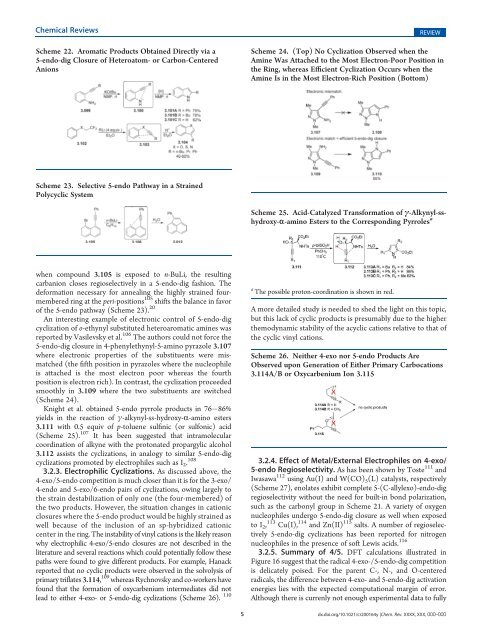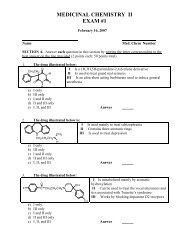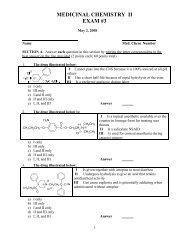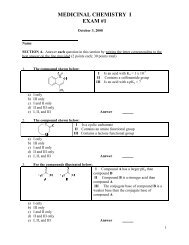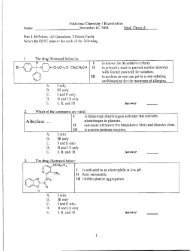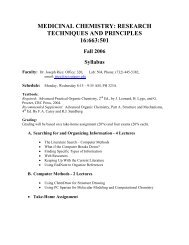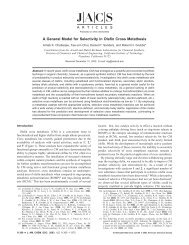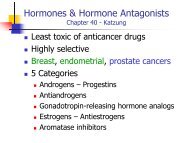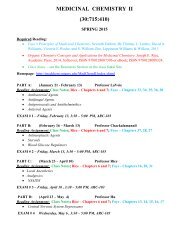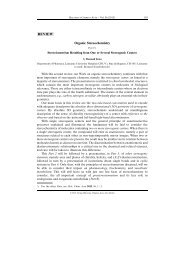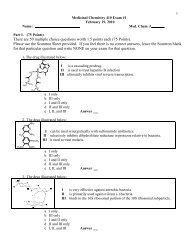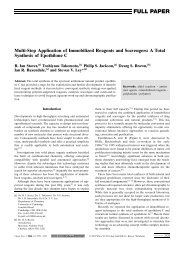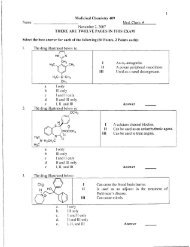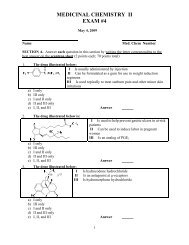Baldwin's Rules - Department of Medicinal Chemistry
Baldwin's Rules - Department of Medicinal Chemistry
Baldwin's Rules - Department of Medicinal Chemistry
You also want an ePaper? Increase the reach of your titles
YUMPU automatically turns print PDFs into web optimized ePapers that Google loves.
Chemical Reviews REVIEW<br />
Scheme 22. Aromatic Products Obtained Directly via a<br />
5-endo-dig Closure <strong>of</strong> Heteroatom- or Carbon-Centered<br />
Anions<br />
Scheme 23. Selective 5-endo Pathway in a Strained<br />
Polycyclic System<br />
when compound 3.105 is exposed to n-BuLi, the resulting<br />
carbanion closes regioselectively in a 5-endo-dig fashion. The<br />
deformation necessary for annealing the highly strained fourmembered<br />
ring at the peri-positions 105 shifts the balance in favor<br />
<strong>of</strong> the 5-endo pathway (Scheme 23). 20<br />
An interesting example <strong>of</strong> electronic control <strong>of</strong> 5-endo-dig<br />
cyclization <strong>of</strong> o-ethynyl substituted heteroaromatic amines was<br />
reported by Vasilevsky et al. 106 The authors could not force the<br />
5-endo-dig closure in 4-phenylethynyl-5-amino pyrazole 3.107<br />
where electronic properties <strong>of</strong> the substituents were mismatched<br />
(the fifth position in pyrazoles where the nucleophile<br />
is attached is the most electron poor whereas the fourth<br />
position is electron rich). In contrast, the cyclization proceeded<br />
smoothly in 3.109 where the two substituents are switched<br />
(Scheme 24).<br />
Knight et al. obtained 5-endo pyrrole products in 76 86%<br />
yields in the reaction <strong>of</strong> γ-alkynyl-ss-hydroxy-R-amino esters<br />
3.111 with 0.5 equiv <strong>of</strong> p-toluene sulfinic (or sulfonic) acid<br />
(Scheme 25). 107 It has been suggested that intramolecular<br />
coordination <strong>of</strong> alkyne with the protonated propargylic alcohol<br />
3.112 assists the cyclizations, in analogy to similar 5-endo-dig<br />
cyclizations promoted by electrophiles such as I2. 108<br />
3.2.3. Electrophilic Cyclizations. As discussed above, the<br />
4-exo/5-endo competition is much closer than it is for the 3-exo/<br />
4-endo and 5-exo/6-endo pairs <strong>of</strong> cyclizations, owing largely to<br />
the strain destabilization <strong>of</strong> only one (the four-membered) <strong>of</strong><br />
the two products. However, the situation changes in cationic<br />
closures where the 5-endo product would be highly strained as<br />
well because <strong>of</strong> the inclusion <strong>of</strong> an sp-hybridized cationic<br />
center in the ring. The instability <strong>of</strong> vinyl cations is the likely reason<br />
why electrophilic 4-exo/5-endo closures are not described in the<br />
literature and several reactions which could potentially follow these<br />
paths were found to give different products. For example, Hanack<br />
reported that no cyclic products were observed in the solvolysis <strong>of</strong><br />
primary triflates 3.114, 109 whereas Rychnovsky and co-workers have<br />
found that the formation <strong>of</strong> oxycarbenium intermediates did not<br />
lead to either 4-exo- or 5-endo-dig cyclizations (Scheme 26). 110<br />
Scheme 24. (Top) No Cyclization Observed when the<br />
Amine Was Attached to the Most Electron-Poor Position in<br />
the Ring, whereas Efficient Cyclization Occurs when the<br />
Amine Is in the Most Electron-Rich Position (Bottom)<br />
Scheme 25. Acid-Catalyzed Transformation <strong>of</strong> γ-Alkynyl-sshydroxy-r-amino<br />
Esters to the Corresponding Pyrroles a<br />
a The possible proton-coordination is shown in red.<br />
A more detailed study is needed to shed the light on this topic,<br />
but this lack <strong>of</strong> cyclic products is presumably due to the higher<br />
themodynamic stability <strong>of</strong> the acyclic cations relative to that <strong>of</strong><br />
the cyclic vinyl cations.<br />
Scheme 26. Neither 4-exo nor 5-endo Products Are<br />
Observed upon Generation <strong>of</strong> Either Primary Carbocations<br />
3.114A/B or Oxycarbenium Ion 3.115<br />
3.2.4. Effect <strong>of</strong> Metal/External Electrophiles on 4-exo/<br />
5-endo Regioselectivity. As has been shown by Toste 111 and<br />
Iwasawa 112 using Au(I) and W(CO)5(L) catalysts, respectively<br />
(Scheme 27), enolates exhibit complete 5-(C-allylexo)-endo-dig<br />
regioselectivity without the need for built-in bond polarization,<br />
such as the carbonyl group in Scheme 21. A variety <strong>of</strong> oxygen<br />
nucleophiles undergo 5-endo-dig closure as well when exposed<br />
to I 2, 113 Cu(I), 114 and Zn(II) 115 salts. A number <strong>of</strong> regioselectively<br />
5-endo-dig cyclizations has been reported for nitrogen<br />
nucleophiles in the presence <strong>of</strong> s<strong>of</strong>t Lewis acids. 116<br />
3.2.5. Summary <strong>of</strong> 4/5. DFT calculations illustrated in<br />
Figure 16 suggest that the radical 4-exo-/5-endo-dig competition<br />
is delicately poised. For the parent C-, N-, and O-centered<br />
radicals, the difference between 4-exo- and 5-endo-dig activation<br />
energies lies with the expected computational margin <strong>of</strong> error.<br />
Although there is currenly not enough experimental data to fully<br />
S dx.doi.org/10.1021/cr200164y |Chem. Rev. XXXX, XXX, 000–000


